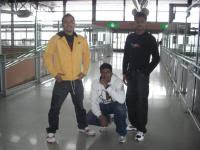September is the ninth
month of the
year in the
Gregorian Calendar and one of four Gregorian months with 30
days.
In Latin, septem means "
seven" and septimus means "
seventh"; September was in fact the seventh month of the
Roman calendar until 153 BC, when there was a calendar reform from the month of the Ides of March to the
Kalends, or
January 1.
[1]September marks the beginning of the
ecclesiastical year in the
Eastern Orthodox Church.[
citation needed] September begins on the same day of the week as December every year, because there are 91 days separating September and December, which is a multiple of seven (the amount of days in the week)Events in September
September, from the Très riches heures du duc de Berry
School starts in September in many countries, such as here, in
Belgium (here is a photograph of the first school day in a school in
Liège)
It is the start of the
academic year in many countries in the
Northern Hemisphere.
On the first Sunday of September, the regata storica parade is staged in
Venice, as prelude to the rowing contests known as
regattas.[
citation needed]
Labor Day (
Labour Day in
Canada) is observed on the first Monday in September in the
United States and
Canada.
In
India,
Teachers' Day is celebrated on
September 5. The date is the birthday of the second President of India, academic philosopher
Dr. Sarvepalli Radhakrishnan.[
citation needed]
In
Japan,
Respect for the Aged Day is a national holiday celebrated on the third Monday of September.
Autumnal Equinox Day is also a national holiday.
In the
United States,
Hispanic Heritage Month is celebrated from
September 15 to
October 15.
[2]Peter Brock and
Steve Irwin, two prominent Australians, both died in September.
In
Mexico,
Independence Day is celebrated
September 15.
[3]In
Brazil, Independence Day is celebrated
September 7In
Saint Kitts and Nevis, National Heroes' Day is celebrated
September 16.
[4]In
Saint Kitts and Nevis, Independence Day is celebrated
September 19.
[5]In
Chile, Independence Day is celebrated
September 18National Grandparents' Day takes place on the first Sunday after
Labor Day in the United States and
Canada [6].
In the
United States,
September 11 is
Patriot Day, in remembrance of the terrorist attacks on
September 11,
2001.
[7][8]In the
Netherlands the third Tuesday in September is known as prinsjesdag. The government presents its annual budget. The queen rides to the parliament in a gilded coach and reads the plans for the coming year to the
States-general.[
citation needed]
The
equinox named the autumnal equinox in the northern hemisphere and the vernal or spring equinox in the southern hemisphere occurs on dates varying from
21 September to
24 September (in
UTC). In the
pagan wheel of the year the spring equinox is the time of
Ostara and the autumn equinox is that of
Mabon.[
citation needed]
In
KwaZulu-Natal, king
Shaka is commemorated on the last Sunday of September.[
citation needed]
Counterintuitively, the German
Oktoberfest and the Chinese
August Moon festival (more correctly called the
Mid-Autumn Festival) both occur in September.
In New Zealand , Father's Day is celebrated on the first Sunday of September.[
citation needed]
In
Australia,
Father's Day is celebrated on the first Sunday of September.[
citation needed]
In
Australia, the Rugby League Grand Final is played on the last Sunday of September.[
citation needed]
In
Australia, the AFL Grand Final is played on the last Saturday of September.[
citation needed]
September 1 is celebrated as the beginning of
Eritrea's 30 year armed
struggle for independence from
Ethiopia, which began in September of 1961 and ended in May of 1991. .




